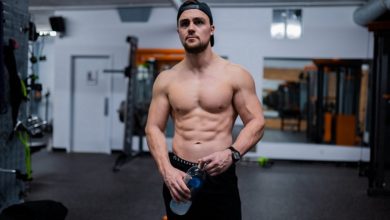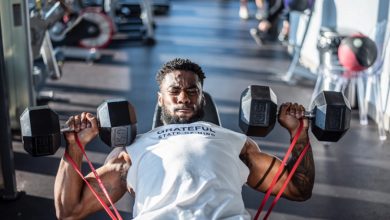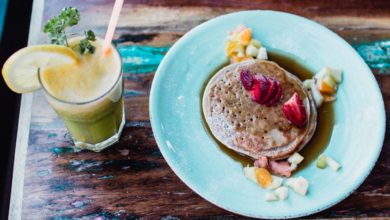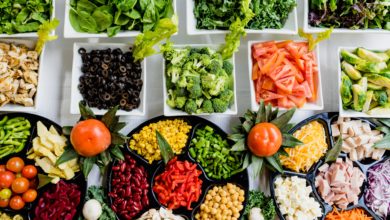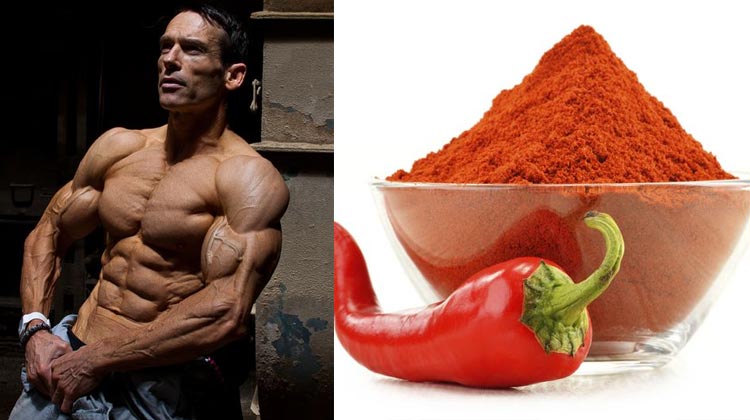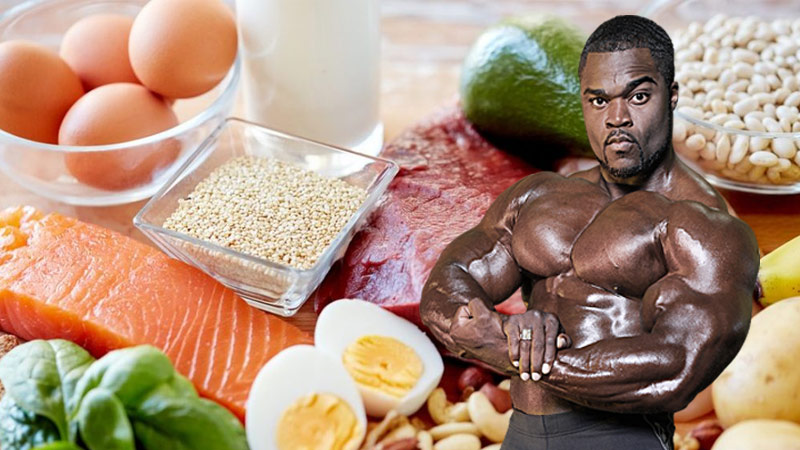
Protein. It’s the one word on the tip of every muscle builder’s tongue. Some of us are downright obsessed with the stuff. In truth, we’d rather miss the birth of our first child than a vital serving. No joke, bro. That’s why you never see bodybuilders in the birthing wing.
Because who wouldn’t, right? From day one we’re slapped in the face with advertisements. Features, articles, and studies, fill up our favorite muscle mags and websites online! Everywhere we turn in the fitness universe people are screaming about the importance of the most marketed macro ever.
“Gotta get enough protein, bro!”
Says Chad, who has more anxiety around aminos than a scrawny runner lost in the free weights section. Apparently, ain’t nothing gonna get in the way of that boy’s gains.
Even if a hurricane was tearing apart his house he’d be running back inside. Not to save the lives of his cat or Grandma, f*ck that. But to rescue all the chicken breast and broccoli stacked in the fridge. Just imagine the horror, bro.
But let’s be honest, Chad’s old meathead mantra is kind of warranted. Protein is indeed an essential nutrient that is imperative for muscle growth.
When you’re hitting those bicep burls on the daily, a guy is going to need a helping or six. Without it, we’d be left looking like a prepubescent Justin Bieber on hunger strike.
Article Bro-down: All the essential sh*t you need to know about the muscle building macro
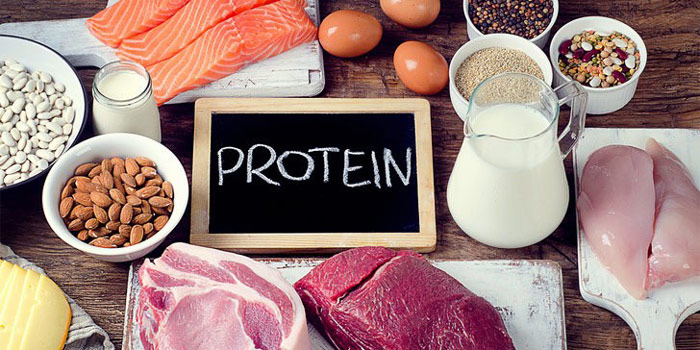
So to take all stress out of the equation we’ve pulled out our thick-rimmed glasses, again.
Barbells have been dropped and we’ve somehow managed to attach nerdy elbow patches on our best stringer. Instead of beasting the power-rack, we’ve dominated the library. Our goal has been to research all the essential sh*t, so you don’t have to.
What follows is a definitive guide to protein, tailored specifically for teaching you how to eat for your goals. Read it, make some notes, gulp a pre workout, then go get jacked, son!
Because you’re a bro put on this earth to do what alphas f*cking do! Lift heavy AF sh*t, bathe in sweet p*ssy nectar, and break the skinny necks of scrawny newbs. Unless you’re a bit of a renaissance man, of course, then it’s also your right to be as smart as you are strong.
Here’s what we found out:
- What protein is
- Why we need it
- Protein’s role in the body
- Optimal daily doses
- Timing tactics
- Top protein rich foods
- Summary
Sweet, bro. Let’s go smash some mind-reps!
So, What Is Protein?
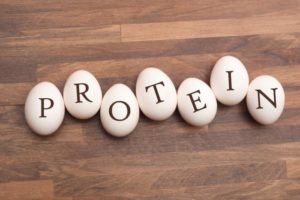
Protein is an essential nutrient that is vital for building and maintaining muscle. Because we need it in quite large amounts, it is classified as a macro-nutrient.
Alongside carbohydrate and fats, it is one of the nutrients we need in the highest quantity.
It can be found in many foods, which are typically animal-based products. Yet plant-based proteins do exist, with varying amounts of aminos found in the likes of beans and soy.
Every gram of protein contains 4 kilocalories (kcals). A calorie is a unit of energy required to raise the temperature of 1 gram of water by 1 °C (4.1868 joules to be precise). So with that being said, a kcal is the unit of energy requires to heat 1000 g by 1 °C.
On a chemical level, protein is a bunch of amino acids all stacked together. These aminos are organic compounds, comprising of carbon, nitrogen, hydrogen, oxygen, and sulfur.
Imagine amino acids as being building blocks that make up the protein structure. There are 20 in total, with 8 being essential, as we cannot naturally create them inside the body. Only 20% are non-essential though, because we do a pretty good job of synthesizing them ourselves.
[infobox]Key point: Protein is an essential macronutrient. Amino acids are it’s building blocks.
[/infobox]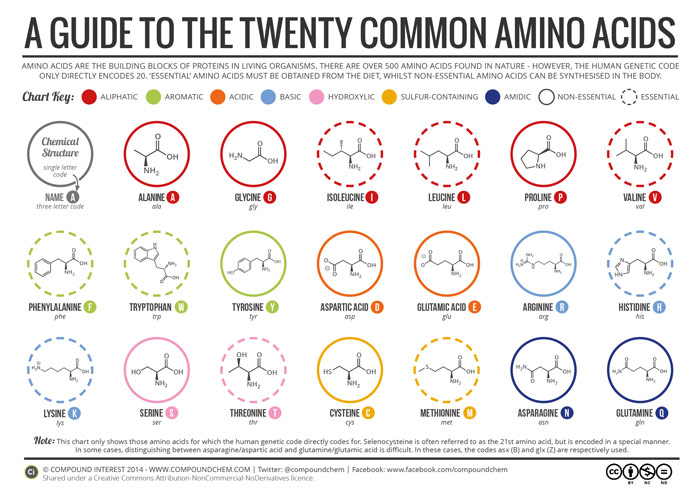
Why Do We Need It?
In the simplest of terms, we need protein to build and repair tissue. It is the main structure of cells inside our body, with a primary function of repairing them.
As a bro who works out like an iron obsessed gorilla possessed by Satan himself, take note. Every time you lift a dumbbell or even get out of your chair, your muscles contract.
When repeated these contractions create varying levels of microtears inside the muscles. Although this sounds bad, it is an intrinsic part of building muscle, so is welcomed by bodybuilders.
What happens next is that a repair response is triggered inside of us. Our body knows it must fix or replace the damaged cells, and then build extra to adapt the muscle, and better prepare it for future stress.
But, in order for the area to be repaired, amino acids in the form of protein must rush to the rescue. Without it, the body cannot produce brand new cells or patch up the old ones.
Protein’s Role in the Body
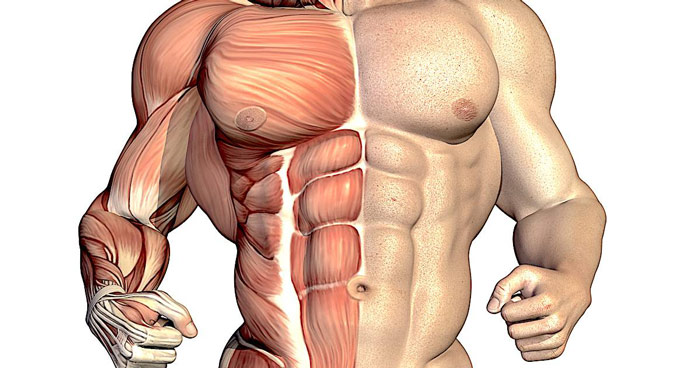
When the essential muscle macro arrives myofibril growth is stimulated.
Here’s the important part for you dude – myofibrils are the filaments that make up every single one of your muscles. Yup, now you’re paying attention.
So when your muscles get a filament boost and additional myofibrils are created during the repair response, you suddenly stack up swole like a savage.
Well, maybe not after the first lift. But if you train hard and are consistent over time, you’ll eventually become a mighty beast.
The breaking down of muscle in this way is referred to as Muscular Hypertrophy. Genetics play a huge part in how well individuals respond to this phenomenon (hard gainers vs easy gainers). Yet, nature has designed the process so it works in the same way for everyone.
[infobox]Key Point: Protein is essential for repairing, maintaining, and building muscle mass.
[/infobox]When We Don’t Get Enough
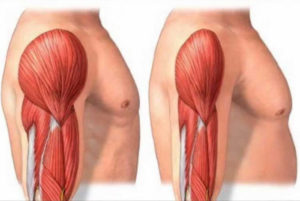
So if you were to put two and two together you’d understand exactly why you need protein.
Without it, your damaged muscles would simply not repair optimally. There’s just no way you’d be able to come back bigger, faster, or stronger.
Instead, you would undoubtedly experience muscle loss. Following that you’d have to face decimated gains and lose the right to swagger chest out confidently through the gym.
If we caught you near our bench we’d squish you underfoot like a worthless bug. Get to the back of the line tiny, watch we don’t pick our teeth with those pins you call legs.
Don’t believe the potential horror story? Check out this terrifying study published in Sports Medicine. Bruh, that’s some Paranormal Activity level scary sh*t.
Going a day without hitting your recommended level shouldn’t leave your gains smoking like a train wreck. However, repeated under-consumption will eventually lead to a deficiency.
Ultimately a deficiency can lead to many health complications. These include; liver problems, anemia, immunity issues, nutrient malabsorption, muscle weakness, and lean mass wasting. All of which will severely hold you back in the weight room, and should, therefore, be avoided at all costs.
[infobox]Key Point: Not getting enough protein can lead to destructive health complications.
[/infobox]Optimal Daily Doses
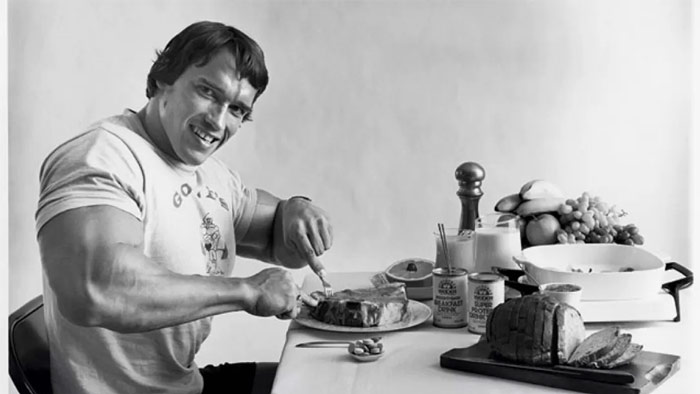
Average American’s should shoot for 0.8 g of protein per kg of body weight, or 0.36 g per lb. For the stereotypical man that’s around 56 g per day, or 46 g per day when talking about the ladies.
Just remember that these numbers are cooked up as a baseline to stop deficiency in regular folk. They’re nowhere near enough for building slices of beefcake for a connoisseur of physique development like yourself.
You’re far from average. In fact, SpotMeBro say f*ck average! The kind of guy that comes to us for a protein guide is jacked like tactical Hummer truck built for a war on mars.
Are your guns are registered deadly weapons in every state? Can’t fly in case your personal gravity field messes up the earth’s orbit? Good! Welcome to the swole patrol, bro. Population 50 000 tonnes.
Fortunately for Judy Dench muthaf*ckers, the International Society of Sports Nutrition published a study on protein consumption for exercising individuals. According to them, 1.4-2.0 g, per kg of body weight, per day, is sufficient for building and maintaining muscle mass.
So to work out your optimal amount then step on the scales and take note of your weight in kilograms (2.2 lb = 1 kg). Then multiply it by a number between 1.4 and 2.0 g, depending on your goals. Go lower for maintenance and then higher for muscle building.
[infobox]Key point: To build muscle aim for 1.4 – 2.0 g of protein per kg of body weight every day.
[/infobox]Timing Tactics
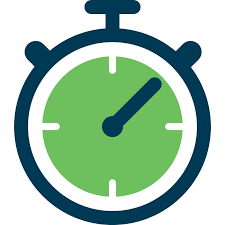 When it comes to feeding your body in the best way, we’ve got to be tactical. Sport is a science and bodybuilding is as intricate as it comes.
When it comes to feeding your body in the best way, we’ve got to be tactical. Sport is a science and bodybuilding is as intricate as it comes.
Our own physiques are a lab of bubbling test tubes and crazy calculations. If we get the formula right, frightening monsters can be grown inside it.
According to the ISSN (2017), the ultimate serving suggesting for athletes to maximize muscle protein synthesis is generally 0.25 g per kg of body weight.
They also recommend that the athlete feasts on the highest quality protein possible. Seeking out a complete amino acid profile throughout the day.
But that doesn’t mean stuff your face in one big binge our amino craving amigo. Trying to pack your daily protein needs into one or two feeds isn’t the best idea.
Research actually suggests that muscle protein metabolism is regulated on a meal to meal basis. So in order to get the most from your meals, it is better to evenly distribute protein evenly through the day. Which, if we are to refer back to the ISSN (2017), is ideally every 3-4 hours.
Eating in this way keeps you anabolic throughout the day. If you’re into pumping iron (of course you are) this means you will be able to grow throughout the entire 24-hour window.
But seriously bro, don’t sh*t yourself in a blind panic if you can’t chug a gross shake .0678 seconds post workout. The famous 20-minute anabolic window myth is just a marketing ploy to scare you into buying powdered crap in a tub. Studies have shown this tiny time frame to be an exaggeration.
[infobox]Key Point: Athletes, especially bodybuilders, should try to consume protein throughout the day every 3-4 hours.
[/infobox]Top Protein-Rich Foods
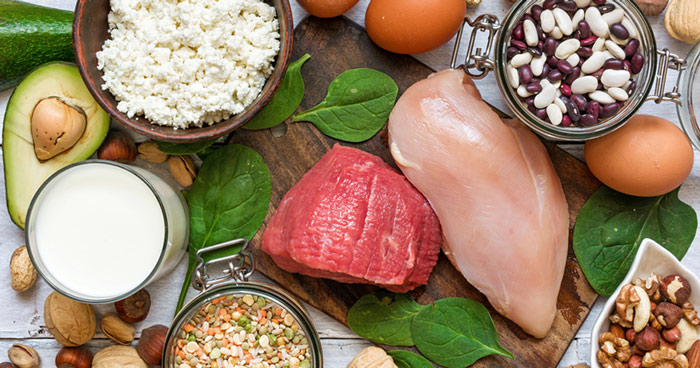
So, now you’re seriously up to scratch on how much protein you need to smash your goals. All you’ve got to do is get some.
Back in the day we’d have slapped our cave-girl on the ass, headed out into the wilderness, and wrestled a wooly mammoth to the icy ground. Either that or take out another amino drenched animal with a 250-yard spear throw. Everyone knows BC stands for Bro-Central, baby!
Unfortunately, that kind of sh*t doesn’t fly these days. Weird smelling, trimmed beard hipsters cry into their organic soy latte around a single whiff of uber-manliness.
Society says you’ve got to find a store with wide enough doors to fit your shoulders through. Dang, good luck with that, dude.
Here is a list of the top protein-rich foods fit for a modern-alphas grocery list:
| Ingredient | Protein per 100 g |
|---|---|
| Eggs | 12.6 |
| Chicken Breast | 20 g |
| Lean Beef (Grilled Steak) | 26.6 g |
| Buffalo | 26.83 g |
| Turkey Mince | 24.2 g |
| Tuna Steak | 24 g |
| Salmon | 19.84 g |
| Soy | 36 g |
| Black Beans | 21.6 g |
| Cottage Cheese | 14.3 g |
Bro Fact: Eggs are the most bioavailable protein source out there. This means the body can utilize it’s proteins more efficiently than anything else.
[/infobox]Summary: Some final thoughts to chew on
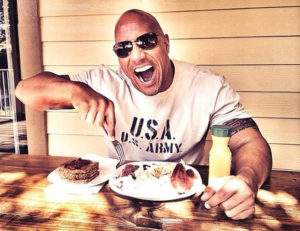
Protein is a vital macronutrient essential for muscle maintenance, repair, and growth.
If we do not get enough we can face health complications; including muscle wastage, malnourishment and liver issues.
For muscle maintenance and building, studies indicate athletes should take in 1.4 – 2.0 g per kg of body weight per day. Considerably less is advised for the nonathletic population.
Therefore, we should aim to take on sufficient protein throughout the day. Evidence suggests that it is better to spread consumption evenly throughout the day. Every 3-4 hours is claimed to be the optimal feeding times for athletes.
Many foods contain varying amounts of protein. Yet it is animal-based sources such as chicken breast, lean beef, and tuna stead, that possess the most readily available amounts. However, that being said, plant-based sources soy and black beans possess considerable amounts.
Eating protein isn’t enough, you have to earn impressive meat too!
Building muscle requires more than just diet alone. In order to forge an impressive physique, you need an impenetrable workout plan to match.
We’d recommend trying BOSS Workouts Lean Mass if you’re serious about stacking size. We tried it, and the results spoke for themselves. Check out our honest and in-depth review here.
If this article got you thinking about how you could take your body to the next level, maybe read:
- Essential Muscle Building Foods for Skinny Guys
- Is Testosterone a Steroid?: Difference Between Testosterone and Steroids
- Carbs and Weight Loss in Bodybuilding: A Complete Guide

